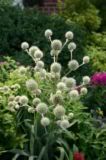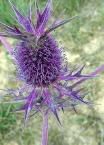

Scientific Name
Eryngium yuccifolium
Uses of Button Eryngo: Landscaping, Medicinal, Culinary, etc...
Rattlesnake master can be used for roadside plantings, prairie restoration, prairie landscaping, wildlife cover, and also in wildflower gardens because of its attractive appearance.
General Characteristics
Rattlesnake master is a warm-season perennial native forb which grows well on wet or dry mesic prairie soil. Plants grow 2 to 6 feet tall from a short, thick rootstock. The bluish green basal leaves are up to 3 feet long and up to 1½ inches wide. The leaves along the stem are much shorter, but they may be as wide as the basal leaves. All the leaves are thick and parallel veined and have soft or weak prickles spaced far apart along the edges. The leaf bases clasp the single, erect stem. Flower heads are on stout peduncles at the tip of the stem. Each nearly spherical flower head is from 1/2 to 1 inch in diameter and is made up of many small flowers. Whitish bracts stick out sharply from the flowers, which gives the flower head a rough, prickly feel and appearance. The heads have a honey-like odor and are in bloom June to September. Individual fruits, which mature in the flower head, are less than 1/10 inch long. The root of rattlesnake master has been used medicinally by American Indians and pioneers. Eryngium is Greek for “prickly plant” and yuccifolium is Greek for “yucca leaves.”
Required Growing Conditions
Rattlesnake master is found generally in wet or dry prairies and open woods in the southeast US, north to Virginia, and throughout the Midwest to Minnesota, Kansas and Texas.
Cultivation and Care
Prepare a clean weed free seedbed by disking and harrowing or using chemical weed control. Firm the seedbed by cultipacking. Seedbed should be firm enough to allow seed to be planted ¼ inch deep. For prairie restoration or diverse plantings for wildlife, rattlesnake master can be incorporated into seed mixes at a rate of 2 oz pure live seed/ac (there are 177,700 clean seeds in one pound of seed). Use stratified seed for spring planting (May to June), and unstratified seed for a fall dormant seeding (November to March). Apply no fertilizer the establishment year unless soil test indicates a severe deficiency of potassium and/or phosphorus. Use no nitrogen during the establishment year as this can encourage weed competition.Transplants planted in spring or fall can also be used for establishing rattlesnake master on permanent sites.
General Upkeep and Control
Reduce weed competition by mowing or using approved herbicides. Burning may be appropriate where plant vigor declines or where invader species threaten native mix stands.
Pests and Potential Problems Lodging has been noted when growing rattlesnake master in a monoculture planting.
Environmental Concerns Rattlesnake master is not considered weedy or an invasive species and has not been noted spreading to adjoining areas. Seedlings have not been noted spreading from original plantings, or if they do spread, the rate of spread is not alarming. Rattlesnake master is self-pollinated.
Cultivars, Improved, and Selected Materials (and area of origin) Three source-identified composites of rattlesnake master from northern, central, and southern Iowa have been released by the Elsberry, Missouri Plant Materials Center.





0 comments: